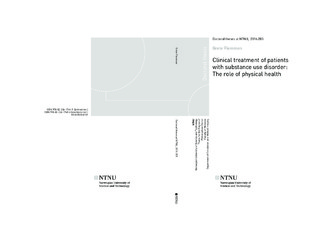| dc.contributor.advisor | Wang, Eivind | |
| dc.contributor.advisor | Mosti, Mats P. | |
| dc.contributor.author | Flemmen, Grete | |
| dc.date.accessioned | 2016-09-05T08:31:38Z | |
| dc.date.available | 2016-09-05T08:31:38Z | |
| dc.date.issued | 2016 | |
| dc.identifier.isbn | 978-82-326-1745-6 | |
| dc.identifier.issn | 1503-8181 | |
| dc.identifier.uri | http://hdl.handle.net/11250/2404186 | |
| dc.description.abstract | It has been well documented that substance use disorder (SUD) patients suffer a high
prevalence of cardiovascular disease, other lifestyle related diseases and have a decreased life
expectancy of 15-20 years. However, their physical health status has been unclear.
Furthermore, it has been uncertain if physical training, as a part of clinical treatment, could be
a feasible and good strategy to counteract the patient groups’ physical as well as mental
challenges.
The objectives of this thesis were:
1. To evaluate key components for aerobic endurance and skeletal muscle strength in
SUD patients.
2. To assess skeletal properties along with skeletal muscle strength and neuromuscular
function in the lower extremities of amphetamine users.
3. Examine the effect and feasibility of high aerobic intensity interval training in SUD
patients in clinical treatment.
4. Examine the effect and feasibility of maximal strength training in SUD patients in
clinical treatment.
In paper I we observed that SUD patients on average had a reduced aerobic capacity (VO2max)
(15% for men and 25% for women), walking efficiency (12% for men and 15% for women)
and maximal strength (30% for men and 33% for women) compared to healthy individuals.
Such reductions are associated with an elevated risk of cardiovascular disease, cancer, mental
health and premature death. In paper II we observed that amphetamine users also suffer
reduced bone mineral density (BMD) (on average 8% for men and 7% for women) at several
skeletal regions compared to healthy individuals. The impairments were accompanied by
reduced maximal muscle strength and rate of force development (RFD). In paper III we
documented the effect and feasibility of a high aerobic intensity training intervention in
clinical treatment. Following the 8 weeks training intervention the SUD patients improved
their aerobic capacity by 15 ± 7%, likely resulting in a substantial risk reduction for
developing cardiovascular disease and other life style related diseases. Similarly as the
aerobic endurance intervention, we documented the effect and feasibility of a strength training
intervention in clinical treatment in paper IV. The eight week maximal strength training
(MST) resulted in large improvements in maximal muscle strength (88 ± 54%) and RFD (82 ±
29%), likely predominantly due to adaptions in the nervous system. The improvements in
muscular strength and function are associated with decreased risk of falls and fractures, osteopenia and osteoporosis and improved motor function and quality of life. Additionally,
both paper III and IV confirmed the attenuation of aerobic endurance and muscular strength in
SUD patients, before the training was carried out.
In general, the physical measurements were not associated with the type of primary drug the
SUD patients were using. This indicates that the systematic physical health reductions SUD
patients suffer may be a consequence of an inactive lifestyle rather than direct damage by the
actual drug use. In conclusion, this thesis advocates the importance of effective physical
training as a part of clinical treatment of SUD patients. | nb_NO |
| dc.language.iso | eng | nb_NO |
| dc.publisher | NTNU | nb_NO |
| dc.relation.ispartofseries | Doctoral thesis at NTNU;2016:203 | |
| dc.relation.haspart | Paper 1: Flemmen, Grete; Wang, Eivind. Impaired aerobic endurance and muscular strength in substance use disorder patients: implications for health and premature death. Medicine, 2015 ;Volum 94.
<a href="http://dx.doi.org/10.1097/MD.0000000000001914" target="_blank"> http://dx.doi.org/10.1097/MD.0000000000001914</a>
This item is Open Access | nb_NO |
| dc.relation.haspart | Paper 2: Mosti, Mats Peder; Flemmen, Grete; Hoff, Jan; Stunes, Astrid Kamilla; Syversen, Unni; Wang, Eivind. Impaired skeletal health and neuromuscular function among amphetamine users in clinical treatment. Osteoporosis International 2016 ;Volum 27.(3) s. 1003-1010 - Is not included due to copyright available at
<a href="http://dx.doi.org/10.1007/s00198-015-3371-z" target="_blank"> http://dx.doi.org/10.1007/s00198-015-3371-z</a> | nb_NO |
| dc.relation.haspart | Paper 3: Flemmen, Grete; Unhjem, Runar Jakobsen; Wang, Eivind. High-intensity interval training in patients with substance use disorder. BioMed Research International 2014 ;Volum 2014.
<a href="http://dx.doi.org/10.1155/2014/616935" target="_blank"> http://dx.doi.org/10.1155/2014/616935</a> Attribution 3.0 Unported (CC BY 3.0) | nb_NO |
| dc.relation.haspart | Paper 4: Unhjem, Runar; Flemmen, Grete; Hoff, Jan; Wang, Eivind. Maximal strength training as physical rehabilitation for patients with substance use disorder; a randomized controlled trial. BMC Sports Science, Medicine and Rehabilitation (2016) 8:7
<a href="http://dx.doi.org/10.1186/s13102-016-0032-2" target="_blank"> http://dx.doi.org/10.1186/s13102-016-0032-2</a>
Attribution 4.0 International (CC BY 4.0) | nb_NO |
| dc.title | Clinical treatment of patients with substance use disorder: The role of physical health | nb_NO |
| dc.type | Doctoral thesis | nb_NO |
| dc.subject.nsi | VDP::Medical disciplines: 700::Clinical medical disciplines: 750 | nb_NO |

